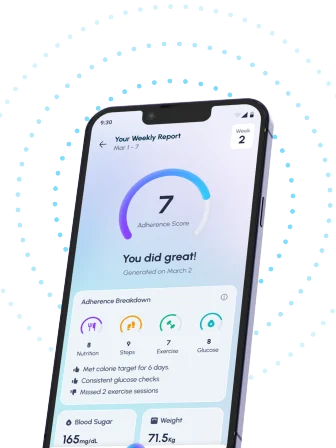Table of Contents
- Understanding Diabetic Peripheral Neuropathy
- Diabetes and Nerve Damage: A Comprehensive Guide
- Peripheral Neuropathy Symptoms: Recognizing the Signs
- Preventing Diabetic Neuropathy: Lifestyle and Treatment
- Managing Diabetic Neuropathy Pain: Effective Strategies
- Frequently Asked Questions
- References
Living with diabetes can present many challenges, and one of the most concerning is the potential for nerve damage. Are you experiencing tingling, numbness, or pain in your hands or feet? If so, you might be dealing with peripheral neuropathy, a common complication of diabetes. This blog post will delve into Understanding the Diabetes-Peripheral Neuropathy Connection, exploring the underlying causes, risk factors, and most importantly, how you can manage and potentially prevent this debilitating condition. We’ll break down the science in a clear, accessible way, providing you with the information you need to take control of your health. Let’s get started!
Understanding Diabetic Peripheral Neuropathy
Diabetic peripheral neuropathy (DPN) is a serious complication affecting 30-50% of people with diabetes, significantly impacting their quality of life. This nerve damage, primarily affecting the hands and feet, results in debilitating symptoms such as pain, numbness, tingling, and burning sensations. In hot and humid climates prevalent in many Indian and tropical countries, these symptoms can be exacerbated by increased sweating and temperature fluctuations. The reduced sensation also increases the risk of undetected injuries, leading to infections and potential limb amputation – a particularly grave concern in regions with limited access to advanced healthcare.
Understanding the Risk Factors
Several factors increase the likelihood of developing DPN. Poorly controlled blood sugar levels are the primary culprit; therefore, strict adherence to prescribed medication and lifestyle changes are paramount. Duration of diabetes is another key factor; the longer one lives with diabetes, the greater their risk. Other contributing factors include obesity, hypertension, smoking, and a family history of neuropathy. In tropical countries, the prevalence of certain nutritional deficiencies might also play a role, underscoring the importance of balanced diets rich in essential vitamins and minerals.
Managing Diabetic Peripheral Neuropathy
Effective DPN management focuses on blood sugar control, as managing blood glucose levels is vital in slowing the progression of the disease. Regular check-ups with a diabetologist and podiatrist are crucial for early detection and prevention of complications. Lifestyle adjustments including regular exercise, maintaining a healthy weight, and avoiding smoking, along with the potential incorporation of regional remedies under medical supervision, are all important elements of a comprehensive management plan. Seeking prompt medical attention is essential for anyone experiencing symptoms suggestive of DPN. Consult your doctor or a diabetes specialist to discuss available treatment options, including medication and physical therapy, tailored to your specific needs and geographical location. It’s important to note that neuropathy isn’t always caused by diabetes; Can You Have Neuropathy Without Diabetes? Causes & Treatment. explores other potential causes and treatment options. For those considering alternative therapies, Can THC Help with Diabetic Neuropathy? discusses a potential avenue, but emphasizes the importance of consulting a medical professional before exploring such options.
Diabetes and Nerve Damage: A Comprehensive Guide
Diabetes significantly increases the risk of peripheral neuropathy, a debilitating condition affecting the nerves in the limbs. This nerve damage often manifests as numbness, tingling, burning pain, and weakness, primarily in the feet and legs. In hotter, tropical climates prevalent in many Indian and other tropical countries, these symptoms can be exacerbated by increased sweating and exposure to the elements. Understanding this connection is crucial, especially considering that nearly 15% of diabetics experience foot ulcers during their lifetime, significantly increasing their risk of amputation.
Recognizing the Symptoms
The symptoms of diabetic peripheral neuropathy can vary, but common signs include altered sensation (numbness or tingling), shooting or burning pain, increased sensitivity to touch, or muscle weakness. Early detection is paramount. Many individuals initially dismiss these symptoms, only seeking medical attention when the condition worsens, leading to serious complications. Regular foot checks are especially vital in warmer climates, where infections can easily develop due to increased perspiration and exposure to the ground.
Managing and Preventing Diabetic Neuropathy
Effective blood sugar control remains the cornerstone of managing and preventing diabetic neuropathy. Maintaining a healthy lifestyle, including a balanced diet and regular exercise, is equally essential. Seeking prompt medical attention is crucial if you experience any symptoms. In tropical regions, particular attention should be paid to foot hygiene and protection from injury and infection. Choosing appropriate footwear and regularly inspecting your feet for any cuts, blisters, or sores can significantly reduce the risk of ulceration and subsequent amputation. Regular check-ups and close monitoring with your healthcare provider are vital in managing this condition and preventing long-term complications. Don’t hesitate to consult your doctor if you are experiencing any symptoms of peripheral neuropathy. The challenges of managing diabetes can increase with age, so it’s important to be proactive. For more information on this, you might find our guide on Managing Diabetes as You Age: Challenges and Solutions helpful. And if you’re planning to travel, Traveling with Diabetes: Essential Tips for a Safe & Healthy Journey offers valuable advice to keep you safe and healthy on the road.
Peripheral Neuropathy Symptoms: Recognizing the Signs
Peripheral neuropathy, a common complication of diabetes, affects millions worldwide. The alarming statistic that 50% of diabetes cases globally remain undiagnosed, as highlighted by the International Diabetes Federation, underscores the critical need for early detection. In Indian and tropical countries, where diabetes prevalence is high, recognizing the symptoms of peripheral neuropathy is particularly crucial.
Numbness and Tingling: Early Warning Signals
Early symptoms often present as numbness, tingling, or prickling sensations in the extremities, typically the feet and hands. This can feel like pins and needles, or a constant dull ache. These sensations may be intermittent at first, worsening gradually over time. Many individuals initially dismiss these symptoms, attributing them to fatigue or minor injuries. However, early intervention is key to managing this debilitating condition.
Pain and Burning Sensations: Progressive Symptoms
As the condition progresses, the numbness can be replaced or accompanied by sharp, shooting, or burning pains. This pain can be intense and debilitating, making even simple activities like walking or sleeping extremely difficult. In hot and humid climates prevalent in many tropical regions and parts of India, these symptoms can be further exacerbated. It’s important to note that pain management strategies may need to be tailored to the specific climate and lifestyle. While peripheral neuropathy is a common complication of diabetes, it’s important to remember that other conditions can also cause nerve pain. For example, you might want to learn more about other conditions presenting with similar symptoms, such as those described in the article on Symptoms of Atrial Myxoma – Expert Diagnosis & Care.
Loss of Balance and Coordination: Serious Complications
In advanced stages, peripheral neuropathy can affect balance and coordination, increasing the risk of falls and injuries. Weakness in the muscles of the feet and legs can also become apparent, leading to difficulties with walking. If you experience any of these symptoms, particularly in conjunction with a diabetes diagnosis, it is crucial to seek immediate medical attention. Don’t delay; early diagnosis and treatment can significantly improve your quality of life and prevent further complications. Consult your doctor for a proper evaluation and tailored management plan. It’s also important to remember that while this article focuses on peripheral neuropathy, other neurological conditions exist. Understanding the differences is crucial for proper diagnosis. For instance, while quite different, the article on Paraneoplastic Pemphigus: Symptoms, Causes and Treatment highlights a rare autoimmune condition affecting the skin and mucous membranes.
Preventing Diabetic Neuropathy: Lifestyle and Treatment
Diabetic neuropathy, nerve damage caused by high blood sugar, is a significant concern, especially in regions like India and other tropical countries with a high prevalence of diabetes. However, the good news is that up to 80% of Type 2 diabetes cases can be delayed or prevented through lifestyle changes, significantly reducing your risk of developing diabetic neuropathy. This emphasizes the critical role of proactive prevention.
Lifestyle Modifications for Prevention
Adopting a healthy lifestyle is paramount. This includes maintaining a balanced diet rich in fruits, vegetables, and whole grains, while limiting processed foods, sugary drinks, and unhealthy fats. Regular physical activity is crucial; aim for at least 150 minutes of moderate-intensity exercise per week. For individuals in India and tropical climates, incorporating traditional forms of exercise like yoga or brisk walking during cooler parts of the day can be highly beneficial. Weight management is also key, as obesity increases the risk of developing Type 2 diabetes. For specific dietary recommendations, you might find our Diet Chart for Diabetic Patients to Control Diabetes helpful.
Medical Management and Monitoring
Regular check-ups with your doctor are essential for monitoring your blood sugar levels and overall health. Early detection and management of diabetes are crucial in preventing neuropathy. Your doctor may prescribe medications to help control your blood sugar and manage any existing nerve damage. Furthermore, incorporating regular foot examinations and addressing any early signs of neuropathy can prevent serious complications. For more comprehensive strategies, see our blog on 10 Proven Tips for Effective Diabetes Management.
Seeking Support in India and Tropical Regions
Many organizations in India and other tropical countries offer support and resources for managing diabetes. Connect with local diabetes support groups, healthcare professionals, and community initiatives to access information, guidance, and community support. Taking proactive steps towards preventing diabetic neuropathy is an investment in your long-term health and well-being.
Managing Diabetic Neuropathy Pain: Effective Strategies
Diabetic neuropathy, a nerve damage complication of diabetes, significantly impacts quality of life, especially in hot and humid climates prevalent across many Indian and tropical countries. Managing the pain associated with this condition is crucial. The added challenge of a 70% increased risk of sleep apnea and related sleep disorders, frequently linked to diabetes, further underscores the need for effective pain management strategies. This can lead to a vicious cycle impacting both physical and mental health.
Lifestyle Modifications for Pain Relief
Regular blood sugar monitoring and strict adherence to your prescribed diabetic diet are paramount. Incorporating regular, low-impact exercise, such as walking or yoga, can improve circulation and reduce nerve pain. Prioritize good foot care, essential in preventing further complications that could worsen neuropathy. Consider using topical creams recommended by your physician to alleviate burning or tingling sensations.
Seeking Professional Medical Assistance
Consulting with a specialist in diabetes and neuropathy is vital. They can evaluate your condition thoroughly and recommend the best course of action, which could include medications, physical therapy, or alternative therapies. Remember that early intervention leads to better management and reduced long-term complications. In many Indian and tropical regions, access to specialists is crucial, so proactive engagement with your healthcare provider is essential. Managing stress effectively can also contribute significantly to better overall health. For helpful tips, check out our guide on Effective Stress Management Tips for Better Diabetes Control.
Holistic Approaches and Regional Considerations
Consider exploring complementary therapies, such as acupuncture or yoga, which have proven effective for some individuals. However, always discuss these approaches with your doctor. It’s also important to note that the climate in many tropical regions can exacerbate symptoms; staying cool and hydrated becomes even more critical for pain management. Finding a balance of effective western medicine and culturally relevant therapies is vital for holistic care within your specific regional context. Remember that emotional well-being plays a crucial role in managing diabetes. Learn more about how to address emotional eating in our blog: Addressing Emotional Eating in Diabetes: Strategies.
Frequently Asked Questions on Diabetes-Peripheral Neuropathy Connection
Q1. What is Diabetic Peripheral Neuropathy (DPN)?
DPN is nerve damage affecting 30-50% of people with diabetes. It causes pain, numbness, and tingling, mostly in the hands and feet.
Q2. What are the risk factors for developing DPN?
Poorly controlled blood sugar, long duration of diabetes, obesity, high blood pressure, smoking, and family history of DPN all increase your risk. Hot, humid climates can worsen symptoms.
Q3. How is DPN managed or treated?
The main focus is on strictly controlling blood sugar levels through medication and lifestyle changes like diet, exercise, and quitting smoking. Regular check-ups with a diabetologist and podiatrist are crucial for early detection and preventing complications.
Q4. Can DPN be prevented, and what should I do if I experience symptoms?
While not always preventable, maintaining good blood sugar control significantly reduces the risk. If you experience symptoms like pain, numbness, or tingling in your extremities, seek immediate medical attention.
Q5. Are there different treatment approaches for DPN?
Yes, effective pain management often combines Western medicine approaches with culturally relevant therapies, especially in regions with hot, humid climates that exacerbate symptoms.
References
- A Practical Guide to Integrated Type 2 Diabetes Care: https://www.hse.ie/eng/services/list/2/primarycare/east-coast-diabetes-service/management-of-type-2-diabetes/diabetes-and-pregnancy/icgp-guide-to-integrated-type-2.pdf
- Thesis on Diabetes Mellitus: https://dspace.cuni.cz/bitstream/handle/20.500.11956/52806/DPTX_2012_1_11160_0_271561_0_118026.pdf?sequence=1&isAllowed=y




